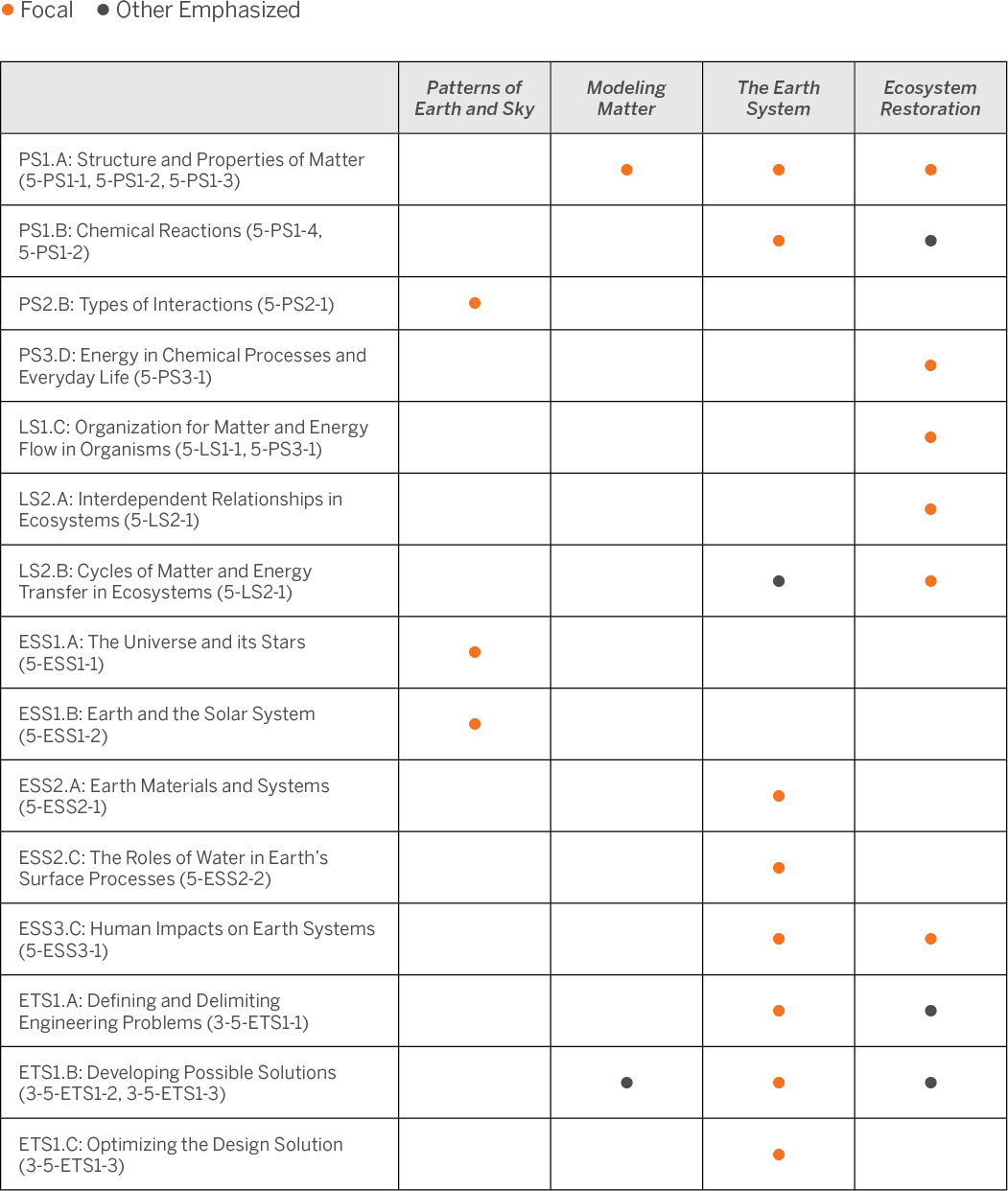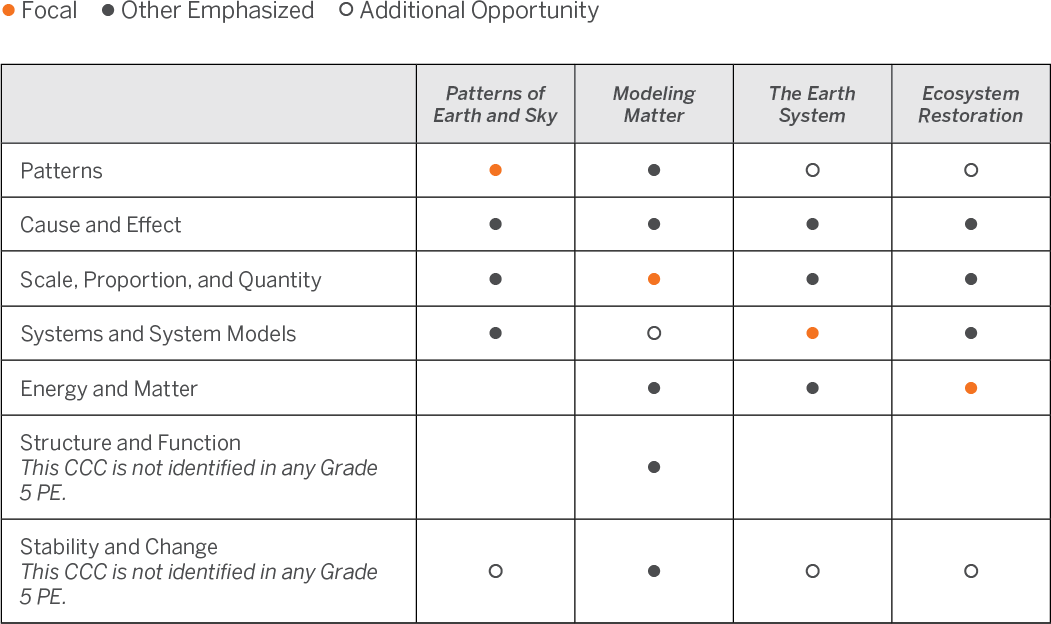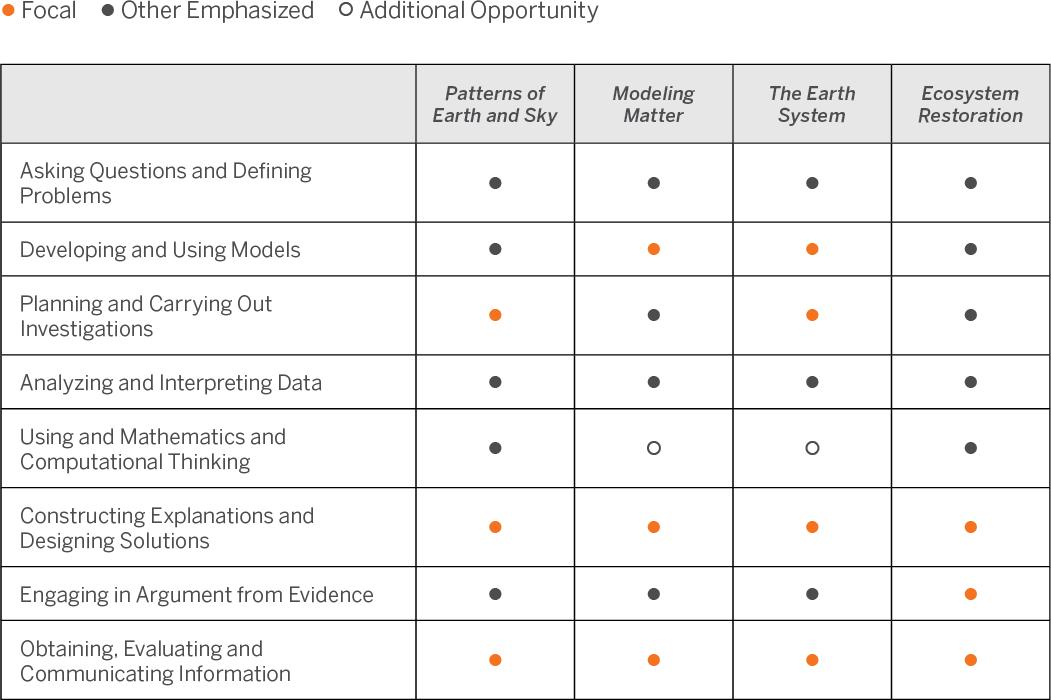Grade 5
The Amplify Science grade 5 program progressively builds students’ abilities to meet all the grade-level performance expectations through a three-dimensional instructional sequence. The following is an overview of the sequence of units, a description of the progression of student learning across the year, and a summary of how the sequence meets the performance expectations for grade 5.
Sequence of units
-
- Patterns of Earth and Sky
- Modeling Matter
- The Earth’s System
- Ecosystem Restoration
Patterns of Earth and Sky
- 5-PS2-1: Gravity
- 5-ESS1-1: Apparent Brightness of Stars
- 5-ESS1-2: Patterns of Daily and Seasonal Changes
Modeling Matter
- 5-PS1-1: Matter is made of Particles
- 5-PS1-2: Matter and its Interactions
- 5-PS1-3: Properties of Materials
- 5-PS1-4: Mixing Substances
- 3-5-ETS1-2: Developing Possible Solutions
The Earth System
- 5-ESS2-1: Interaction of Spheres
- 5-ESS2-2: Distribution of Water on Earth
- 5-ESS3-1: Protecting Earth
- 5-PS1-1: Matter is Made of Particles
- 5-PS1-2: Conservation of Matter
- 5-PS1-4: Mixing Substances
- 3-5-ETS1-1: Defining Problems
- 3-5-ETS1-2: Developing Possible Solutions
- 3-5-ETS1-3: Improving Solutions
- 5-LS2-1: Ecosystems: Interactions
- 5-PS1-3: Properties of Materials
Ecosystem Restoration
- 5-LS1-1: Plant Materials from Air and Water
- 5-LS2-1: Matter Flows
- 5-ESS3-1: Protecting Earth
- 5-PS1-1: Matter is Made of Particles
- 5-PS3-1: Use and Origin of Energy in Food
- 5-PS1-4: Matter and Its Interactions
- 3-5-ETS1-1: Defining the Problem
- 3-5-ETS1-2: Developing Possible Solutions
Progression and organization
The units in grade 5 were designed and sequenced to build students’ expertise with the grade-level disciplinary core ideas (DCIs), science and engineering practices (SEPs) and crosscutting concepts (CCCs). Each unit has focal SEPs and CCCs, carefully selected to support students in figuring out the unit’s focal DCIs.
Students begin the year with a focus on patterns in the daytime and nighttime sky in the Patterns of Earth and Sky unit. Physical models and an initial focus on scale help students make sense of the vast distances to the stars, and the focal CCC of Patterns supports students’ identification of and sense-making about patterns in the sky. Students use a digital simulation as they engage in the focal SEP of Planning and Carrying Out Investigations to gather evidence to support their ideas about sky patterns. Next, students turn their attention from the tremendous scale of outer space to the nanoscale of the particles that make up matter in the Modeling Matter unit. By delving more deeply into the practice of Developing and Using Models and focusing on the CCC of Scale, Proportion, and Quantity, students develop a nuanced understanding of how properties of matter at the nanoscale affect observable scale phenomena. Students also extend their experience with investigations as they conduct hands-on investigations of substances and mixtures.
In The Earth System unit, students build on their understanding of matter and the relationship between nanoscale and observable scale phenomena. The context of a water shortage pushes students to delve deeper into ideas about the properties of matter and chemical reactions, as well as concepts related to Earth system interactions, water distribution, and human impact on the environment. Students apply their understanding of these interdisciplinary ideas as they engage in the focal SEP of Designing Solutions, iteratively designing solutions to a water shortage problem. A focus on the CCC of Systems and System Models supports students to construct an understanding of how the hydrosphere, atmosphere, and geosphere interact, and students apply a systems lens to engineering design. Finally, in the Ecosystem Restoration unit, students gain further experience with the nature of matter, human impact on the environment, and engineering and design, but with a focus on the movement of matter and energy in ecosystems. The focal CCC of Energy and Matter supports students in understanding the necessary and limiting role that energy and matter flows play in an ecosystem. Students also build on their learning about systems and system models as they use systems thinking to analyze ecosystems. By engaging in the focal SEP of Engaging in Argument from Evidence, which has been introduced in the year’s earlier units, students make sense of what is causing a rain forest ecosystem to fail and what should be done about it.
The DCIs emphasized in each unit work together to support deep explanations of the unit’s anchor phenomenon (or phenomena). For example, in the Patterns of Earth and Sky unit, investigating why an ancient artifact seems to show patterns in the daytime and nighttime sky leads students to construct ideas about The Universe and its Stars (DCI ESS1.A), Earth and the Solar System (DCI ESS1.B), and Types of Interactions (DCI PS2.B).
Disciplinary core ideas

Crosscutting concepts

Science and engineering practices
